Representing Refugees 1: The World Captures Escapees at Its Funeral
29/06/2016
Author: Roger Outa
Photographer: Annabel Guerrero
The picture in which Aylan Shenu appears reveals a glaring conundrum: From which direction did the child touch the shore? If from the sea, his corpse seems to deny it because it faces the water; if from the mainland, his wet clothes serve as a further reminder that their wearer died drowned.
The child touched the shore from both directions simultaneously, for he travelled land and sea and fell in their environment, their milieu. And since his body then longed for the water, it seemed as though both sides were behind him; as though he had avoided them. And as he navigated their exterior, death seized him. Land was behind him and so was the sea. But that which the waves revealed is the “exterior,” the locus of the escapees and that to which they continuously strive.
Aylan’s position recalls that of the escapees from “Assad’s Syria.” The escapees are halfway between the Immortal Regime and the Death State, on one side, and the world order, on the other. But this does not mean that the land on which they stand is beyond that of the Baath and before that of the world. Rather, it settles in their midst and traverses them; it is equally their milieu and their exterior. According to Newton’s definition, the milieu is constituted of a fluid substance that liquefies the escapees’ world of possibilities. As such, escapees travel land and sea; they flow, they gather, they disperse, they crystallize, and in so doing, they are action, one that is intense and mobile.
The Essence of Elimination and the Gist of Representation
The Immortal Regime deals with the exterior of the escapees, their milieu, as a nonexistent entity. As the Regime hardly concedes that its surrounding is not its interior, it naturally denies the existence of anything that lies beyond these surroundings. On the other hand, the world order deals with the exterior of the escapees not as exterior at all, but rather as a distance that separates it from the Baathist state and draws its residents towards it. The Immortal Regime tells the escapees: “No exit. You do not exist.” The world order tells them: “You have not reached the exterior yet. The closer you come to it, the more you enter into me, for I am the exterior.”
Both the Immortal Regime and the world order negate the exterior of the escapees; the former by eliminating it and the latter by representing what it imagines their exterior is. Although elimination is not representation, it is implicit in it. Although representation is not elimination, it revolves around it, just as the Baath regime is the essence of the world order, its deepest interior, and just as it the world order revolves around it, at its furthest exterior.
The world order believes that the escapees’ milieu, their exterior, lies beyond the Immortal Regime and precedes it. Hence, the world order’s conception of this milieu prevents it from orbiting its Baathist essence, drawing thereby the Baathist essence closer. As such, the world deliberately sets out to interact with the escapees either by turning a blind eye to their murder and drowning—in so doing almost emulating its Baathist essence by reiterating the statement “You do not exist”—or by welcoming them and presenting itself as their exterior, attempting thereby to orbit its Baathist essence all over again. In the first instance, the world internalizes the escapees’ exterior by eliminating it and capturing its inhabitants as dead bodies; and in the second, the world internalizes the escapee’s exterior by representing it and capturing its inhabitants as living bodies.
In that context, the picture of Aylan was described as a “blow to the world’s conscience.” When the world order saw the picture, it was shocked by the picture’s clear representation of both the escapees’ position and the world as a land that preceded them. It portrayed a drowned child, who nevertheless was still facing the sea, indifferent to that which appeared behind him: immortality, death, and the world—for despite his death, the child did not retract, as if unfazed by his own demise. In his picture, Aylan overcame his death. He was alive, so much that the world crashed into him and decided to consume him.
For this reason, Aylan’s image became “the symbol of refugees.” If symbols mark a relationship forged between two entities using a certain signifier, the world awaited this image to become aware of the existence of these escapees. It used the picture to relate to the escapees, based on what it saw in it, what it interpreted in it. But instead of relying on a signifier to relate to the escapees, the world relied on itself. For as it witnessed the escapees defeat their death, the world pronounced them dead; it interpreted their flight as a mere quest for asylum; it read the moment of their flight to the exterior as its own. The world’s actions may be reduced to its oft-repeated phrase: “The picture speaks to the cowardice in us.” Through the picture of Aylan, the world established a relationship with its own interior: it gripped it, or rather retracted to it, then decided to expand it, making it spread out into its exterior. The world did not relate to Aylan or the escapees, for it was afraid of what they might do to its interior from which it leaned out to capture them. And the more it captured them, the tighter it clutched at itself.
The Abyss as the Pinnacle of Superiority
Nilüfer Demir took Aylan’s picture, but it was the world order that captured him. There is a difference between the two moves: Capturing stems from a desire to arraign the escapees, suspend their mobility, and frame it in asylum. Capturing reduces escape to asylum, which suggests overwhelming terror. Taking pictures, on the other hand, stems from a desire to push escapees to rearrange their movement, to intensify it, to keep it clear of looming traps. The world visually captures, and in so doing, it bolsters its conception of the escapees and encloses them in the frame that it had set.
However, the picture of Aylan was the image-pinnacle insofar as the world order relied on its interior to capture it, in order to present itself to the escapees as their exterior. The other side of this image-pinnacle is the image-abyss seen in this video in which the camera captures escapees relying on the essence of the world, the Baath regime. It films them from above as though they are a flock of loose cattle. When switching scenes, the camera seems to eliminate the content of the first scene to be able to switch to the other. The escapees in this video are a band of barbarians, terrorists, and extremists that must be captured from above, military-style, in order to do away with them.
There is no distinction between the world order capturing Aylan in a picture and capturing escapees in this video. This is due to the interplay of the interior and the essence. It is as though the world deals with escapees in one way only, that of capturing, according to two equations: When it wishes to internalize the escapees, the world captures them as though it is their exterior, and thereby relies on its interior. When the world wishes to banish them, it captures them from above, thereby relying on its essence. In the image-pinnacle, the world collides with the escapees’ movement and attempts to limit it by internalizing it, whereas in the image-abyss, it crashes into the escapees’ movement and attempts to control it by repudiating it. In the image-pinnacle, the world sees the escapees as utterly helpless “individuals,” whereas in the image-abyss it sees them as rampant and lawless “groups.” In the image-pinnacle, the world entraps the escapees in its own imaginary, whereas in the image-abyss, it does not confine them, but rather obliterates them.
This is what some of the escapees’ pictures connote. The pictures are not disseminated based on what they contain, but rather on their association with other images depicting fighters from ISIS. As such, escapees that seem like refugees in one image and therefore internalized by the world, appear as Islamic jihadists in other images, triggering the world’s desire to extract, arrest, and eliminate them.
The Permanence and Condition of Alienation
The world order not only contends itself with manufacturing an image of refugees by monopolizing and representing the exterior, but also transforms the milieu in which they lie to another, in line with Lamarck’s and later Auguste Comte’s definitions. The world cannot view this milieu as exterior, as a terra firma that gives life to the escapees’ movement. Rather, the world stares at this milieu as a constellation of conditions that surround those who inhabit them and mark them. Based on this premise, the world continues to capture escapees depicting them as though they are overwhelmed by alienation and misery, as if they are eternally walking in their own procession and not in that of the Immortal Regime and the world order that revolves around it.
The picture of Laith Majid was widely disseminated as a depiction of a refugee weeping for joy upon reaching the world. The world is the source of his joy and the end of his trials. But the image’s cardinal points seem to contradict such interpretation. It suggests that Majid did not weep for joy for having reached the world—keeping in mind that the shore is not the world—but rather, he wept for joy because he was overwhelmed by the realization that death, his close companion throughout his flight, materialized before him. When death appears, it means it has begun to recede. The escapee sensed death looming before him, beyond the coast, and so he covered his son’s face, while his daughter willingly turned away from what lies before her and gazed at the sea. Death had approached, clear as day, from the shore, from the world, but after life had defeated it, it vanished into the sea.
Interpreting Majid’s picture as the world resignifies the milieu and reduces it to the conditions surrounding it. The world appears as though it monopolizes the joy of the escapees after having confined them in the image of perpetual misery. As such, even if escapees seem joyful in pictures, their joy is continuously represented as an obstacle to misery. The world captures them by focusing on their conditions, articulated by their grim faces and ensures thereby that their conditions remains difficult in order to validate itself as a source of absolute good.
The escapees must deny themselves in order to validate the world. They must be miserable to please the world. They must dwell in their misery and pain for the world to remain a source of absolute good. It is not true that the world helps the escapees gratis, neither it is true that the world gives them all in exchange for nothing, for reality almost proves the opposite. The world takes life form Syrians in exchange for a grim representation of their lives; it takes their exterior and gives itself in exchange for itself; it takes their milieu in exchange for its conditions; it takes their means for joy—no matter how lonely it may feel—in exchange for its sinister delight that slowly ushers them to their eternal procession.
As such, the world order addresses its citizens: “Observe those who linger at your borders. They want to have your conditions. To become like you.” So, when citizens look at the escapees, they use the world order’s eyes. Their gaze is that of world’s enmeshment with its Baathist Immortal essence. And thus, they call for the pursuit and arrest of any refugee, having first cast doubt on the truth of these so-called “difficult conditions,” as revealed by this image used to question the needs of smartphone-owning refugees. Otherwise, their gaze penetrates the world’s interior, its representation of the exterior. They rejoice that they, at last, have done away with the escapee that lurks within them, one that cannot them or discharge them, for they have seen the escapee right before them, at their borders. And so, they prove to themselves that they are not refugees.
But in both instances of capturing escapees—as a means to eliminate them or as a means to observe them—the watchers stay cloistered in their world order and its essence, clinging to it as though it is a catalyst for life. The most this order can do for escapees is to address its citizens using the escapees’ images, convincing them further of its raison d’être, reassuring them that they will never be refugees themselves.
The artist Annabel Guerrero probed ways of photographing refugees without revealing their identities or features, and without turning cameras into police lenses that display the refugees’ portraits in border control centers. Guerrero’s question is vital and may be extended and problematized: How can one take the escapees’ pictures without capturing them? How can their movement be shown in all its peculiarities? How can it be liberated from regimes that may detain it in its deadly interior or eliminate it by continuing to orbit its immortal essence? How can the refugees’ exterior be safeguarded without transforming it into the world, or their milieu safeguarded without turning it into its surrounding conditions?
The photographer Samuel Gratacap found that the best way to take pictures of escapees is to use the camera as a means to draw maps for them. This way, photographs materialize as a collection of landscapes that do not impede the escapees, but rather grant them movement. Guerrero built on Gratacap’s approach by portraying not the escapee’s faces, but rather the lines drawn on their palms. These lines, she said, are identities that do not identify them, but rather uphold their existence. But at the same time, it is impossible to control the escapees by unifying or distinguishing between them. Furthermore, these lines are the very paths that they have forged and taken, for these Syrians put their life, their fate, and their strength on the line.
This piece was translated from Arabic click here for the Arabic text.



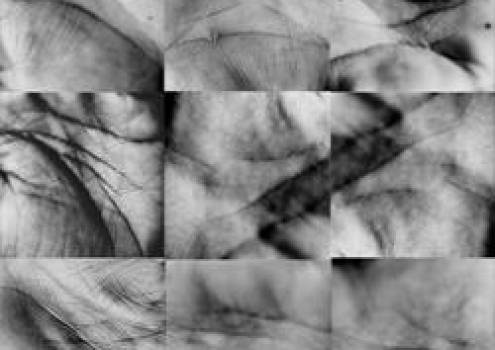




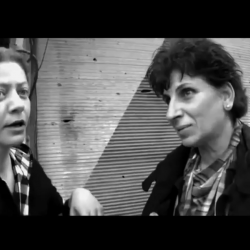
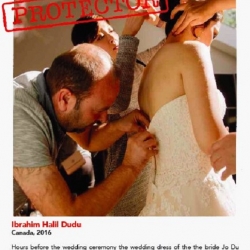
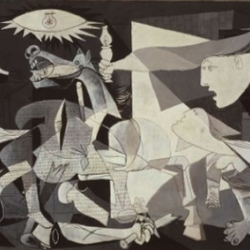
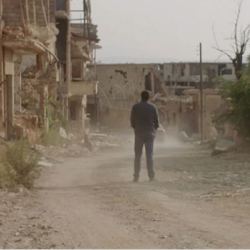
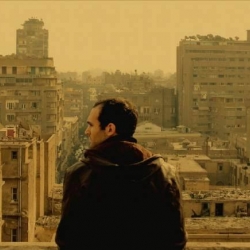
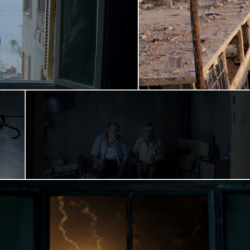
.jpg)
